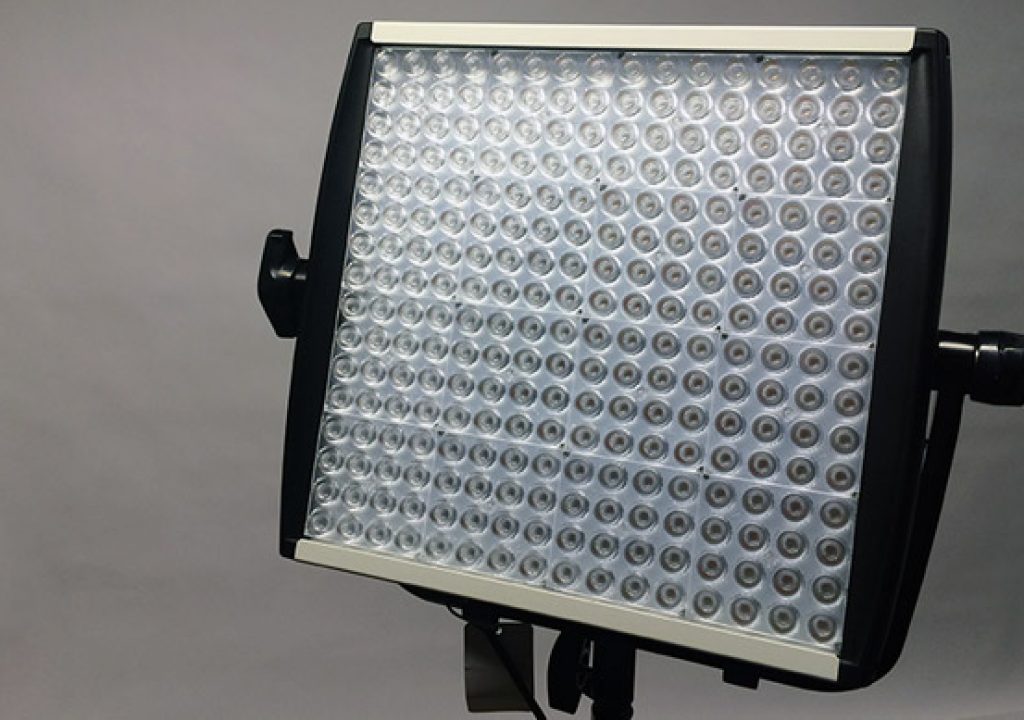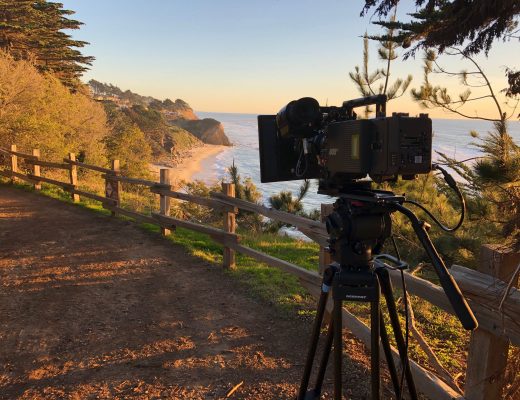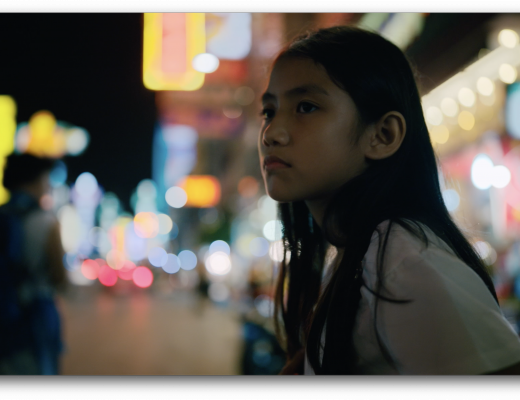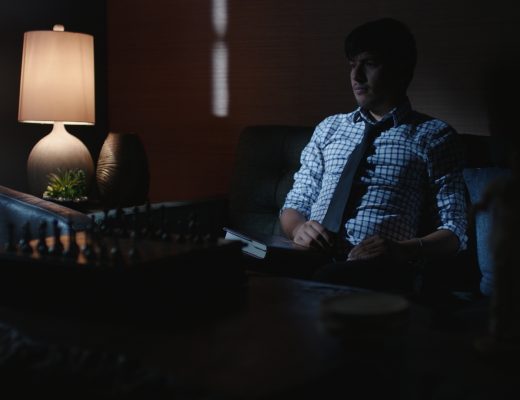The Litepanels Astra is the next-generation 1×1 LED light from the company that invented the first generation. After Litepanels founded the genre, a lot of companies followed its lead with cheaper — and, more lately, competent clones — but the $1350 Astra raises the bar again with dual daylight/tungsten LEDs , high-powered output, DMX expandability and a nice ecosystem of light-shaping accessories. It’s easily the best 1×1 panel I’ve come across.
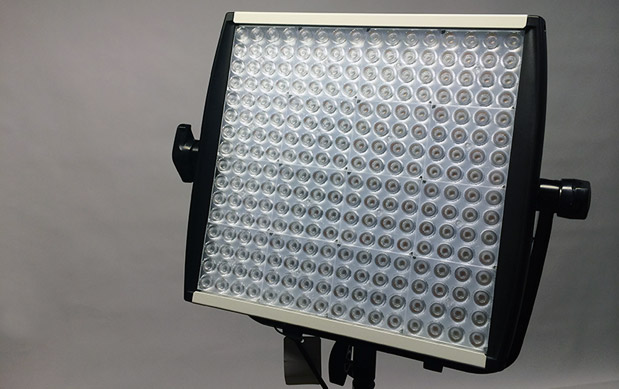
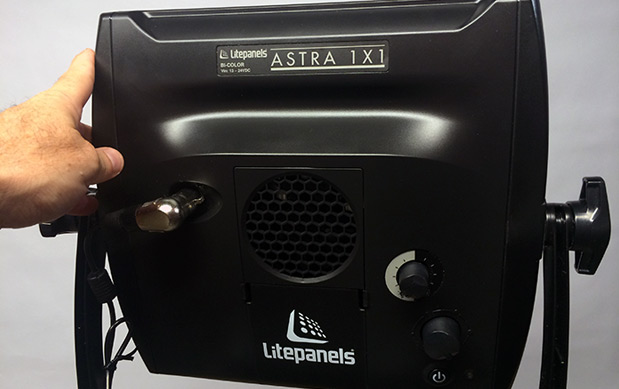
What I’m most enthusiastic about is the Astra’s sheer output. At full power, the Astra sucks up 100 watts and puts out the equivalent of a 1000-watt tungsten light. To help quantify that, I used my light meter to measure the Astra’s output from about 5 feet, comparing it to two other 1×1 panels I had laying around — one was an older Litepanels 1×1 Daylight Flood, and the other was a third party bi-color knock-off that was nonetheless high quality and a good match for Litepanels’ pre-Astra bi-color models. The Astra measured f11.6 in full daylight mode, while the old-school Daylight Flood model hit f5.6, and my high-quality clone came in at f5.6 4/10s.
So the Astra was more than two stops brighter than my previous go-to LEDs, which let me do things I could never do with the other 1×1 panels. One example: I was shooting an interview in a room with shady, ambient daylight coming in through a couple of windows. I pointed the Astra into the ceiling to noticeably bring up the overall level of the entire room. Secondly, the Astra can actually add decent fill when you’re shooting outside in daylight. I’m used to the light from 1×1 LEDs getting swallowed up in anything but the shadiest of shade, but the Astra can definitely make an appreciable dent in brighter situations.
A few other impressions:
- As for color fidelity, I found that my Canon C300’s white balance measured the warmest setting on the Astra’s bi-color dial at 3000 kelvin, and the coolest setting at 5800 kelvin. By turning the bi-color dial in just slightly, I was able to hit more conventional 3200 and 5600 kelvin settings, but the Astra is sufficiently accurate in its warm/cool range. If you need to warm or cool the light further, Litepanels sells a collection of CTO and CTB gel panels in quarter, half and full strengths that are specifically tuned for the light’s LED panel. Each gel set lists for about $180, and includes a bag. As for CRI, Litepanels doesn’t have a number to report just yet, but I compared a Chroma Du Monde chart lit by both the Astra and a Dedo tungsten light, and wasn’t able to spot appreciable shift in particular colors. I saw no weird green or magenta shift that some cheap-o LED panels still produce.
- The light has a built-in fan, and when you’re running at full power, the fan whirls away subtly. But I don’t think its noise will ever be a concern for the majority of jobs, especially since I noticed that my own Canon C300 camera’s fan was actually louder. Still, if you ever need dead silence from your light, you can turn off the fan and the light will run at half-power and brightness. The fan is also user-replaceable in the field, in case it ever goes on the fritz.
- With the Astra, you don’t need to pay more for an altogether different model that supports DMX networking (which lets you control the light’s dimming, color temperature and fan speed remotely, and work it into various automation systems). Every Astra has a built-in accessory bay on the back, where you can plug in a small DMX accessory. I didn’t get a chance to test this, but street price will be around $270, which seems pretty reasonable for the option.
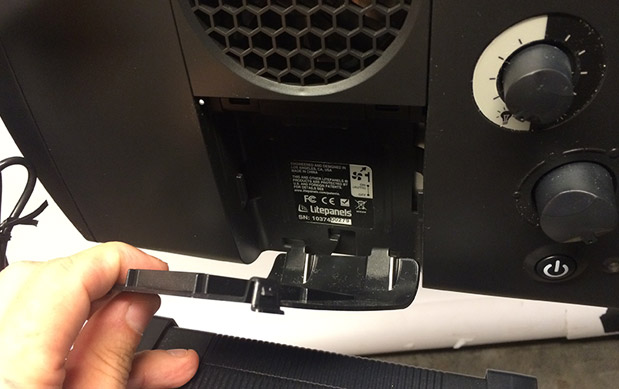
You'll plug the Astra's DMX add-on right into this bay.
- You’ll be able to add an Anton Bauer or V mount adapter to power the light on a big battery. Litepanels doesn’t have a shipping date yet, but the adapter plate should cost $155 list, and will attach to the light’s robust yoke (since the Astra’s backside is curved plastic, you can’t just mount the battery plate to the back of the light itself). Just keep in mind that the Astra draws 100 watts at full power, which meansthat your batteries aren’t going to last nearly as long as with other 1×1 panels.
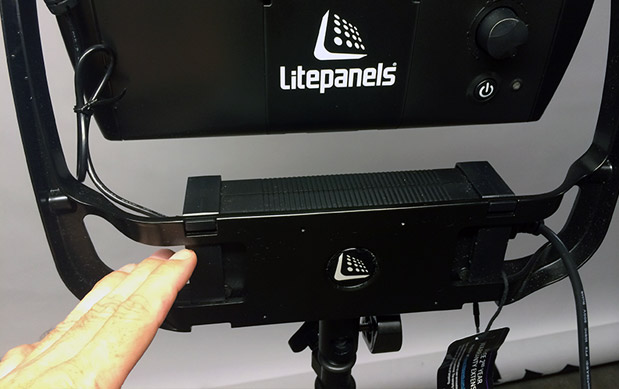
The light's power supply is held in place by its yoke. Battery adapters attach there as well.
- Litepanels is also making a range of light-shaping accessories available, which slip into grooves built into the Astra’s front face. There’s an Opal Frost slip-in gel (about $35 list) that diffuses the light and helps removes the micro shadows cast by the light’s multiple LEDs. There’s also a set of slim, laminated “nanoptic” lenses that can focus the light’s native flood beam spread, giving you options for 30 degrees, 60 degrees, and horizontal/vertical effects ($495 list). There’s also a soft box option (called a “snap bag”, $260) that quickly snaps to the Astra, and works with different diffusion fabrics ($85). You can add an optional 40 degree grid to that, so there’s really a genuinely flexible solution for softening and still controlling light, without putting up additional stands.
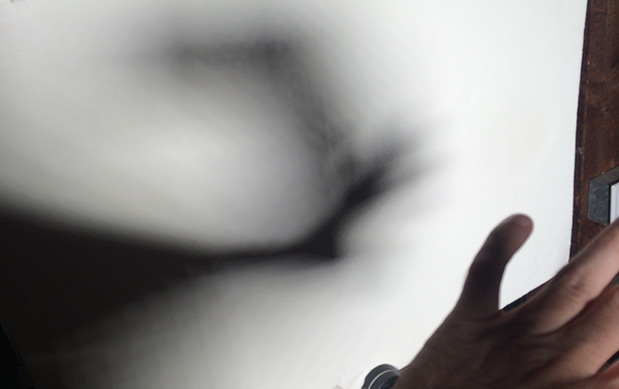
Without diffusion, the Astra's multiple LED lights cast micro shadows on closeup subjects.
- The Astra’s dimming and bi-color control dials are different sizes so you can more easily tell them apart, but I wish they had printed a more detailed legend on the dials so you'd know where you had set things, precisely.
- At 7 pounds, the Astra is about twice as heavy as my older Litepanel 1×1. Part of that weight gain comes from the light itself, and the other part from the heavier-duty yoke that’s installed on the light.
THE FINAL VERDICT
I developed a lot of affection for the Astra over the two weeks I used it. Its high-powered output, expandability and light-shaping accessories make it the most versatile LED 1×1 I’ve come across. I also appreciate the Astra's street price of $1350, which is appreciably cheaper than Litepanels’ older bi-color unit. It probably won’t take too long for competitors to boost their light output, and they’ll probably be able to undercut the Astra’s price as well. But I’m skeptical that they’ll match the Astra's easy accessory options, DMX expandability, 2 year warranty, and Litepanels’ world-wide support.
Pros
- Very bright by 1×1 panel standards
- Bi-color (tungsten to daylight)
- Good color fidelity
- Add DMX networking at any time
- Good accessories for filtration and light-shaping
- Fairly affordable
Cons
- A little heavier and bulkier than your average 1×1 panel
- Accessory options get pricey
Helmut Kobler is a Los Angeles-based DP and cameraman. www.losangelescameraman.com.

Filmtools
Filmmakers go-to destination for pre-production, production & post production equipment!
Shop Now